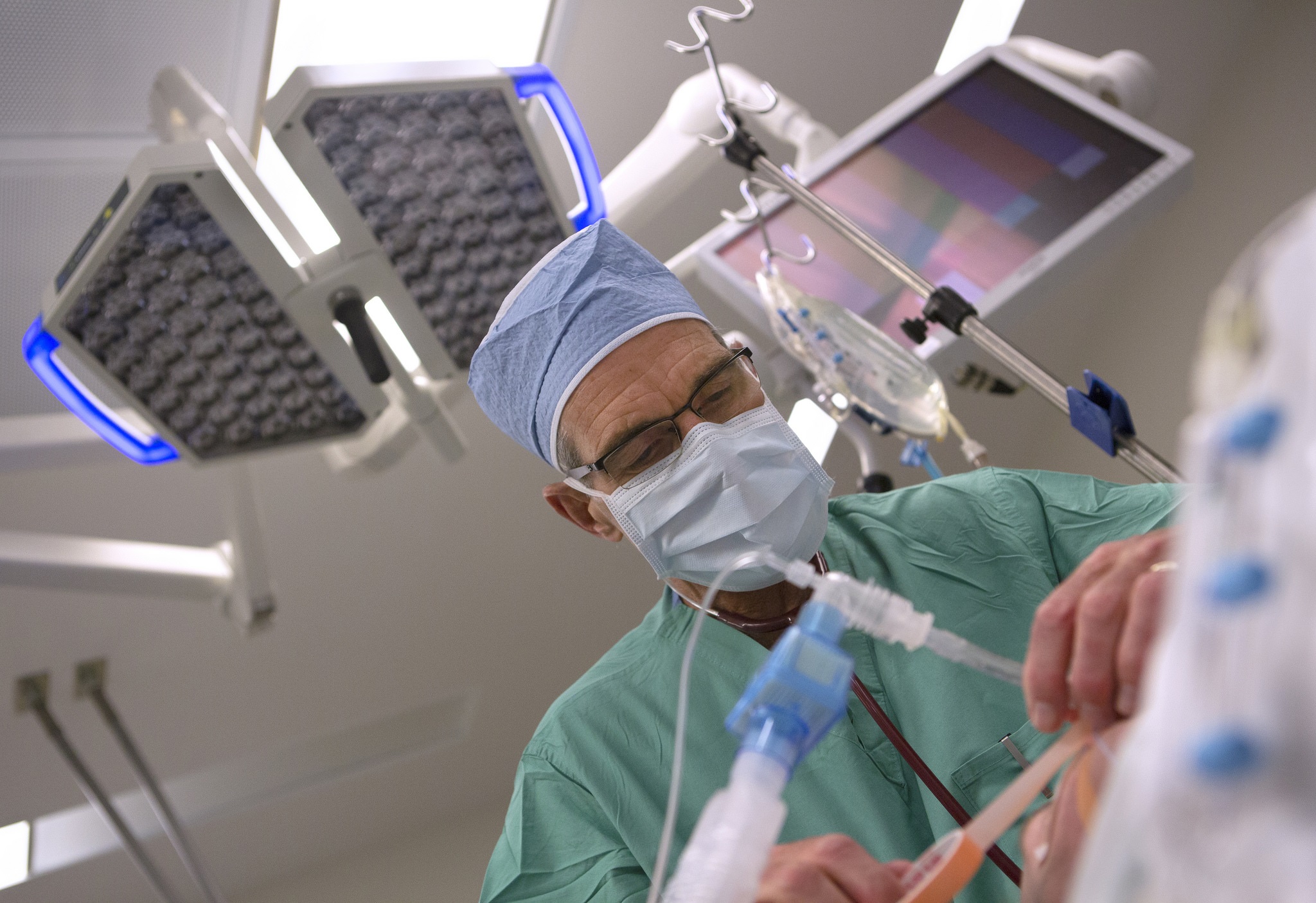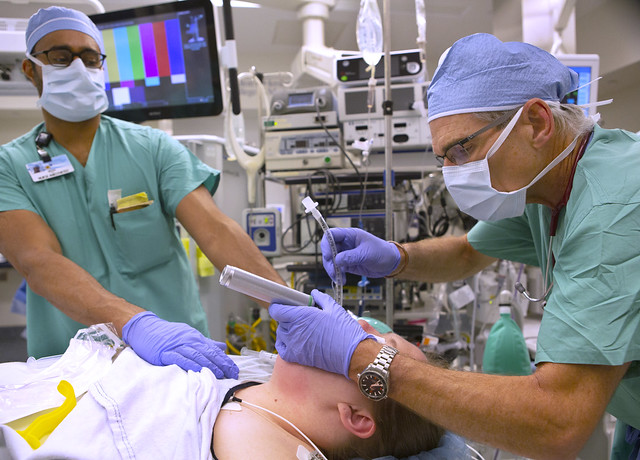After nearly 200 years of anesthesia practice, are patients waking up safer?

Dr. Berend Mets secures the endotracheal tube of a patient during an operation at Hershey Medical Center.
By Katherine Brind’Amour
That’s the question Dr. Berend Mets, chair of the Department of Anesthesiology and Perioperative Medicine at Penn State Health Milton S. Hershey Medical Center seeks to answer with his new book, “Waking Up Safer? An Anesthesiologist’s Record.”
“The public has the misperception that anesthesia is just sleep, which we euphemistically call it to allay anxiety,” says Dr. Mets. “It’s not sleep—it’s a medically induced coma. The minute you’re under, your airway can collapse, and it’s our job to keep it open and continually provide oxygen to supply your brain. Anesthesiology doesn’t get the respect it deserves for its importance.”
The book weaves Mets’ personal anesthesiology stories—starting with his training in South Africa using rudimentary techniques, through his practice in England and New York to his current position in Pennsylvania—with the history of anesthesiology. From the field’s advent in 1846 to his own present-day practice at the Milton S. Hershey Medical Center, Mets explains what has contributed to making surgery safer with time.
“I wanted to tell stories about anesthesia and the people who led its quest for safety, using my career to illustrate the development of the specialty,” says Mets. “It started with literally just a finger on the pulse and a blood pressure cuff for me, and now 35 years later it’s similar to the cockpit of a Boeing 737. The transformation is astounding.”
Has this change been meaningful, though? Are patients waking up safer now than 60 years ago, when anesthesia outcomes were first truly measured?
“Yes—we’ve seen about a 90-fold increase in safety,” says Mets. “This has happened as a result of putting protocols in place, the development of new drugs, methods for enhancing recovery, better monitoring, new equipment, written plans for each patient and many more standardized processes. That’s what makes the history of anesthesia so rich and worth an entire book. It’s been moving a mile a minute.”
Beyond the technical side of the field’s advancement is the thrill of its perch on the fine line between life and death. It is precisely this sense of danger and mastery over the complex interaction of body, breath, blood and drugs that appeal to Mets.
“You’re never more alive than when you’re scared to death,” says Mets. “I think that’s why anesthesiologists get into the field. It’s important—you work with lethal drugs that would, in other circumstances, kill the patient. But you manage them to safeguard the patient and allow lifesaving operations or critical diagnostic procedures to take place.”
His passion for exhilarating experiences doesn’t end in the operating room. Having traveled to more than 80 countries, Mets includes highlights of his adventures in the autobiographical sections of his book.
“Dr. Mets was the perfect person to write a book about the history of anesthesiology, not only because of how he has seen the field advance as a whole since the early 1980s but also because of his own journey, practicing anesthesiology in so many different places,” says Dr. Joseph Answine, clinical associate professor of anesthesiology at Penn State College of Medicine and a colleague of Mets. “It’s about time someone wrote about the historical adventure of anesthesia in a way patients can understand. He really shows patients it is a daily struggle to hone our art and make anesthesia as safe as we do.”
See Dr. Berend Mets at work in the operating room on the Medical Center’s Flickr page.
Dr. Mehmet Oz (best known for “The Dr. Oz Show”) also praised the book in an advanced review, calling it “very engaging and lots of fun” and mentioning that Mets captured the “wild, wild west” feel of the practice of anesthesiology in their younger years. Mets hopes the stories of his own practice and those of others will help introduce the true complexity of anesthesiology to a broad audience of patients.
After all, Mets has not just observed the evolution of anesthesia passively. For the past 15 years, he has guided the Department of Anesthesiology and Perioperative Medicine at Hershey Medical Center in clinical practice, urging the institution of new protocols and processes to keep patients safer. Most recently, he and his department of more than 200 clinicians completed adoption of the Vortex process. The approach, developed by a physician in Australia, provides anesthetists and support staff with a visual guide to identify and resolve life-threatening airway problems during anesthesia. It helps improve patient safety and further reduces the danger of “going under.”
“The Vortex approach created a standardized process for managing difficult airways, which can be deadly,” says Mets. “These problems are complex and frequent, and now we have a way to guide all of our clinicians through the most challenging situations they face. It’s just another great example of our profession’s never-ending attempt to protect patients and make anesthesia safer.”
Read more about Mets, his book and the practice of anesthesiology on his website, www.BerendMets.com.
If you're having trouble accessing this content, or would like it in another format, please email Penn State Health Marketing & Communications.

